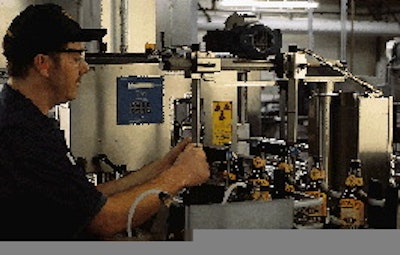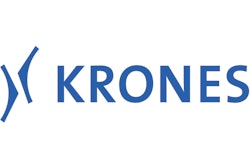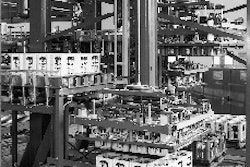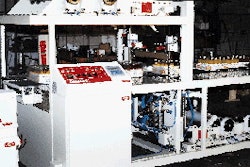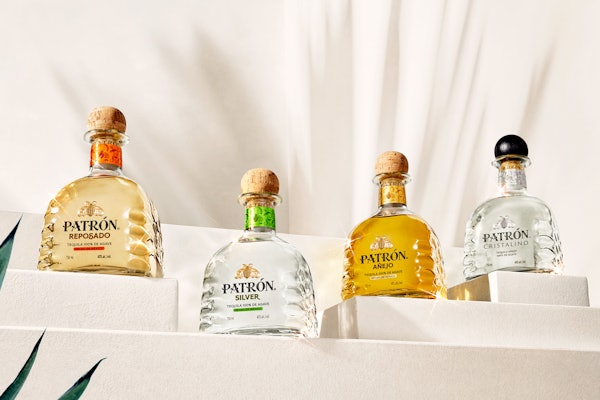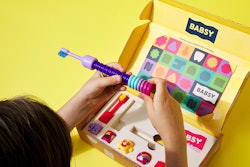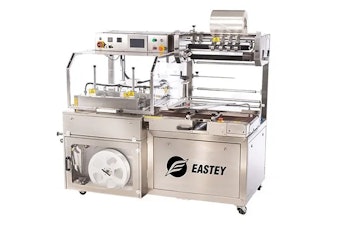Regional specialty brewer Widmer Brothers' $25 million investment in a new bottling facility in Portland, OR, emphasizes the microbrewer's bullish outlook. That's a substantial outlay in an overall flat beer market, especially for a company that expects to ship between 140ꯠ and 160ꯠ barrels this year. Factors that make the investment look prudent include: o Continued sales gains of specialty beers such as those produced by Widmer, o 76% company growth from 1995 to 1996, and o the May '96 introduction of glass bottles (it had previously sold beer only in kegs) to expand distribution eastward. The beer is now sold in 17 states. Since founding Widmer Brothers in 1984, Kurt and Rob Widmer have produced a variety of German-style draft "biers." According to Tim McFall, director of marketing, Widmer beers aren't pasteurized or filtered. Instead, he contends, microorganisms are controlled by "keeping our plant, equipment and piping extremely clean," along with the beer kept under refrigeration from the time it's palletized to the time it's displayed on the shelf. Until the spring of '96, all of Widmer's sales were in kegs. The company felt that packaging in kegs alone would limit future growth, as it's costly to have kegs returned from remote locations. Looking toward future growth, Widmer built the new bottling facility directly across the street from the keg filling plant. Each plant has its own fermentation cellars, with kegs filled on one side of the street, bottles on the other. However, both produce the same beer formulations. Widmer also added stainless-steel piping beneath the street so that it would have the flexibility to produce beer from either side, then pump it as needed to the bottling or keg side. The addition of the bottling line expanded the 65ꯠ sq' Portland facility's total capacity to 310ꯠ barrels/yr from 70ꯠ. Last year, Widmer shipped 122귔 barrels. Today Widmer bottles six beers, one "hard cider" and a winter seasonal beer. However, the brewer faced its share of skeptics when it decided to package in glass. Skeptics questioned whether Widmer's specialty brews like "Hefeweizen" could maintain the same flavor in bottles that they had in kegs. "Our customers tell us that the beer in bottles is indistinguishable from our draft beer," notes Kurt Widmer, president and CEO. "That was an important production goal. If we didn't think we could accomplish that, we wouldn't have gone ahead with the market expansion." Passing inspection While ingredients and processing techniques create the flavors that Widmer beers are known for, quality control doesn't end there. It's important during bottling operations as well. Key to maintaining quality on the line are three Filtec inspection systems from Industrial Dynamics (Torrance, CA). One inspector checks for fill levels and missing crowns, another for missing or misplaced labels, while a third checks filled cases for missing or damaged bottles. "The Filtec units from Industrial Dynamics are really the Cadillacs of the industry," notes packaging manager Bob Magruder. "They're the best on the market." They're also rated to operate at more than twice the 520-bpm speed at which Widmer runs. After depalletizing, bottles are carried through most of the filling line on conveyors from Bevco Conveying Systems (Surrey, British Columbia, Canada). "These are all state-of-the-art, computer-controlled conveyors," says Magruder. Bottles are ink-jet-coded with a pull date. Shelf life is between 90 and 110 days, depending on the variety. After rinsing, bottles are conveyed to a Krones (Franklin, WI) 66-valve gravity filler/crowner that Magruder says "is rather unique. It uses a double-evacuation process which means we get much of the air out of the bottle before we fill it, which goes back to the issue of improving quality. The machine includes a crowner that crimps metal crowns onto the bottle." Widmer fills beers at about 43°F. The Krones machine, says Magruder, is rated to fill beer at up to 60°F, without encountering foaming difficulties that would slow line speeds. Bottles continue through the filler's discharge starwheel to the crowner's infeed star. Later they're rinsed with water to spray foam off bottle exteriors. Next is the first Filtec FT-50 inspection unit. This system inspects for gross fill level and missing crowns. Since the beer still maintains a head of foam at this point, Widmer personnel reduced this inspector's sensitivity to take into account foam density. Essentially, this inspector detects bottles grossly underfilled. "The filler actually detects missing crowns," explains Sebastian Pastore, director of brewing operations. The filler is designed to detect missing crowns before they discharge from the crowning station. The machine may be set to shut down the filler after one to 20 consecutive uncrowned bottles are detected. Widmer has it set to shut down the filler after four such bottles pass uncrowned. "We catch all of the bottles with missing crowns with this first Filtec," Pastore notes. Crowned bottles continue to a Krones Topmatic labeler that automatically applies body and neck labels, using cold glue. Afterward, a second Filtec inspector rechecks the fill level; since the foam has settled, it's more precise. "The second inspector satisfies our compliance requirements to assure that the bottles we label as holding 12 ounces actually contain that volume," adds Pastore. This second inspector also checks for missing body or neck labels, rejecting any bottle that's missing either. Labeled bottles are then case- packed on a drop packer. Bottles are case packed in three configurations: four six-packs, two 12-packs, or 24 singles within dividers. Configurations vary, depending on the needs of distributors, retailers and other customers. Whatever the configuration, the third Filtec system measures the relative density of each case, automatically rejecting any case with a missing or broken bottle. Subsequently, a machine cuts and closes tablock flaps. Cases are sealed shut with hot melt glue. An ink-jet coder codes the case before they're automatically palletized. Pallet loads are then stretch wrapped in a refrigerated area prior to distribution on refrigerated vehicles. 'Seamless' conveying Industrial Dynamics and Bevco worked together to custom design deceleration transfers to gently remove bottles rejected at each of the inspection system stations, without causing breakage. A pneumatic impulse rejector pushes the rejected bottle with a specially designed impact pad that minimizes the bottle's rotating motion, moving it slowly onto a separate conveyor section that leads to an accumulation area. Bevco supplied a zero-pressure combiner that moves empty bottles from depalletizing into a single-file lane before rinsing and then back to mass flow after filling. A second combiner performs a similar function before and after labeling. "As we look to reduce material costs with the use of lighter-weight bottles, breakage on a conveying system can become a problem," notes Magruder. "I haven't seen a single bottle break on one of our Bevco combiners. We achieve product savings by eliminating breakage, and labor savings because our personnel don't need to un-jam bottles on the combiners." Speaking of labor, only four operators are used to manage the entire line. These well-trained people handle start-up, line sanitation duties, light maintenance and changeovers. The latter, Magruder notes, average only once a week. "It's not a complicated packaging/product mix," he says. "The Filtec systems are designed for easy operation and quick, accurate changeovers. Anybody could learn [how to change-over the inspectors] with very little training because it's so intuitive." Promising future Justification for the $25 million plant, explains Tim McFall, "will be measured in the long term. When we put in bricks, mortar and equipment, we looked at it as another investment. We're shipping more than 40 percent of our volume in bottles. We expect bottles and kegs to account for a pretty even split of our volume in the future." Beer is currently shipped to 17 states, concentrated primarily in the West. Bottle labels, carriers and cases all help sell the product. That's particularly important in the competitive beer business. These packaging components, McFall tells Packaging World, "may be the only advertising devices we have in a retail outlet, so they're a big key for us in getting the consumer to buy beer." Widmer hopes that once consumers try the product, the taste of these specialty brews will keep them coming back for more. On average, Widmer six-packs are priced in the $6.49 to $6.99 range at retail. The taste goes back to quality control issues. When it comes to bottling line QC, the role of the Filtec inspectors is significant. "We want as much information as we can about what is being packaged so that we can assure the highest-quality product goes out the door," concludes Sebastian Pastore. "Each of the three Filtec inspection systems gives us unique and useful information about our product. The combined effect of the systems creates the quality assurance and production efficiencies we were looking for."
